Nursing Report: Comparing Elderly Care in Hong Kong and the USA
VerifiedAdded on 2020/10/04
|10
|3117
|36
Report
AI Summary
This nursing report presents two case studies exploring elderly care in different settings: old age homes and families. The report investigates the social determinants of health, health-related risk factors, and strategies for addressing these factors in both contexts, with a particular focus on the cultural differences between Hong Kong and the USA. The analysis highlights the impact of cultural beliefs, social class, and ethnicity on the health and well-being of elderly individuals. The report also provides recommendations for improving elderly care, including the implementation of health committees, feedback mechanisms, and awareness programs. The similarities between the two case studies include the common issue of depression among elderly people, while differences arise from the varying cultural contexts and healthcare approaches. The ultimate goal is to improve the quality of life and reduce health risks for elderly populations.
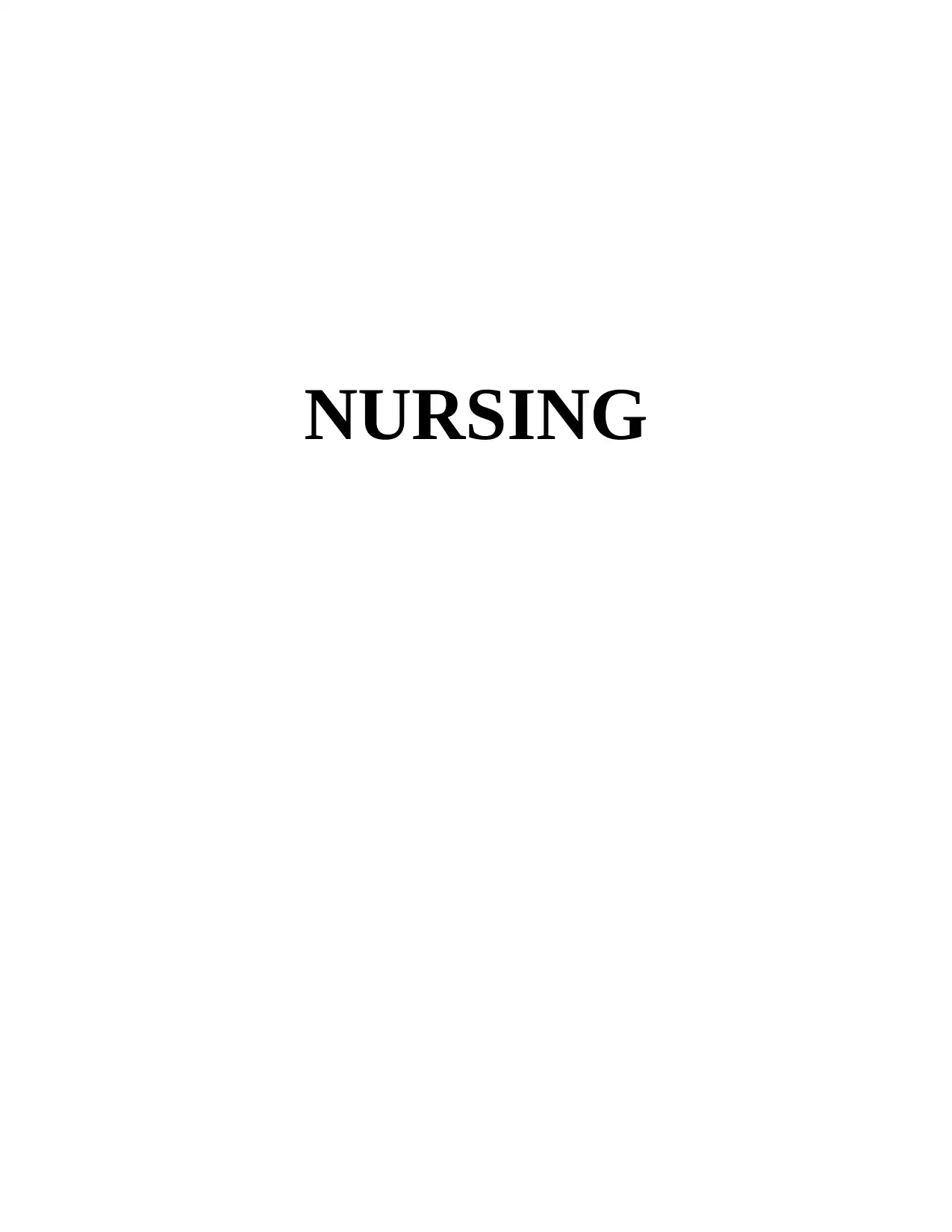
NURSING
Paraphrase This Document
Need a fresh take? Get an instant paraphrase of this document with our AI Paraphraser
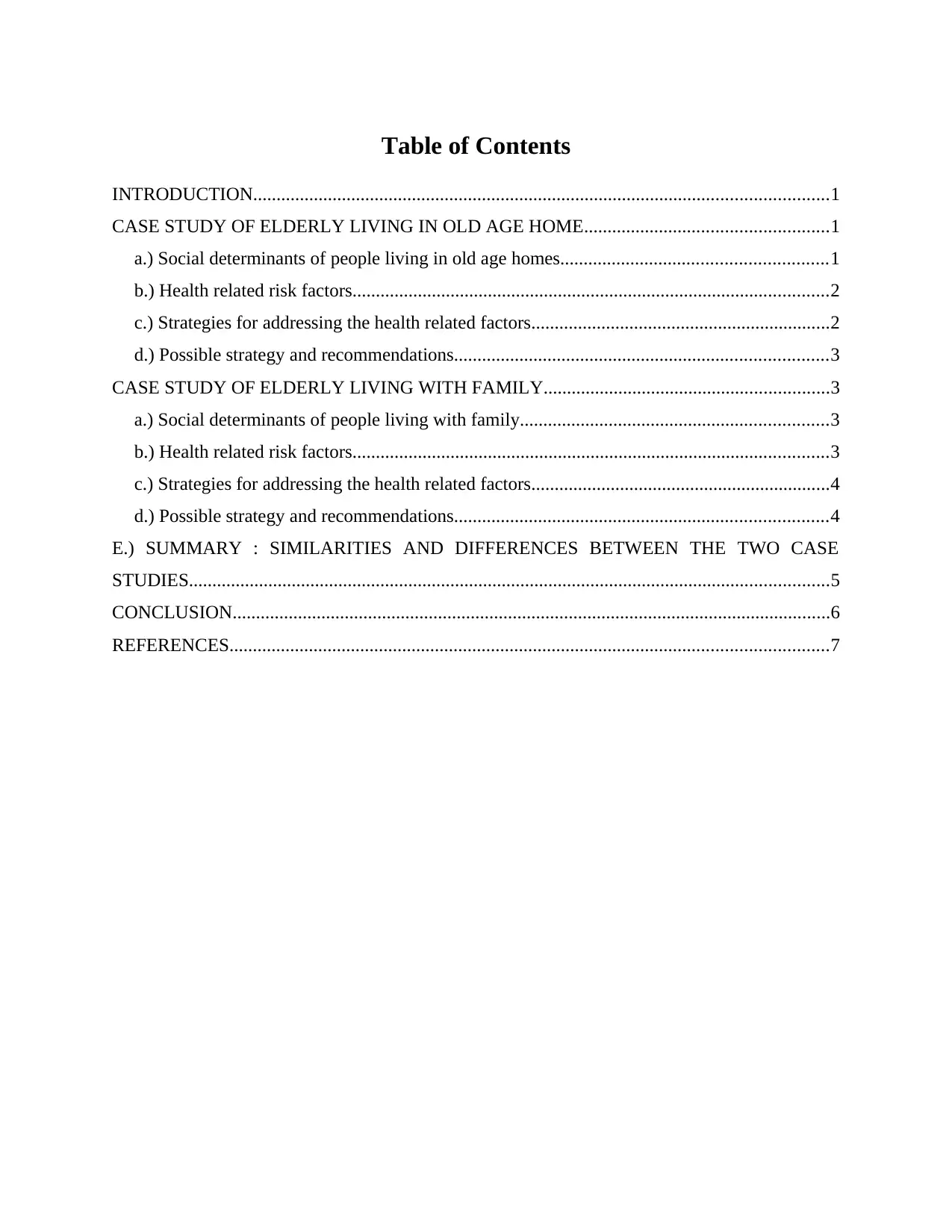
Table of Contents
INTRODUCTION...........................................................................................................................1
CASE STUDY OF ELDERLY LIVING IN OLD AGE HOME....................................................1
a.) Social determinants of people living in old age homes.........................................................1
b.) Health related risk factors......................................................................................................2
c.) Strategies for addressing the health related factors................................................................2
d.) Possible strategy and recommendations................................................................................3
CASE STUDY OF ELDERLY LIVING WITH FAMILY.............................................................3
a.) Social determinants of people living with family..................................................................3
b.) Health related risk factors......................................................................................................3
c.) Strategies for addressing the health related factors................................................................4
d.) Possible strategy and recommendations................................................................................4
E.) SUMMARY : SIMILARITIES AND DIFFERENCES BETWEEN THE TWO CASE
STUDIES.........................................................................................................................................5
CONCLUSION................................................................................................................................6
REFERENCES................................................................................................................................7
INTRODUCTION...........................................................................................................................1
CASE STUDY OF ELDERLY LIVING IN OLD AGE HOME....................................................1
a.) Social determinants of people living in old age homes.........................................................1
b.) Health related risk factors......................................................................................................2
c.) Strategies for addressing the health related factors................................................................2
d.) Possible strategy and recommendations................................................................................3
CASE STUDY OF ELDERLY LIVING WITH FAMILY.............................................................3
a.) Social determinants of people living with family..................................................................3
b.) Health related risk factors......................................................................................................3
c.) Strategies for addressing the health related factors................................................................4
d.) Possible strategy and recommendations................................................................................4
E.) SUMMARY : SIMILARITIES AND DIFFERENCES BETWEEN THE TWO CASE
STUDIES.........................................................................................................................................5
CONCLUSION................................................................................................................................6
REFERENCES................................................................................................................................7
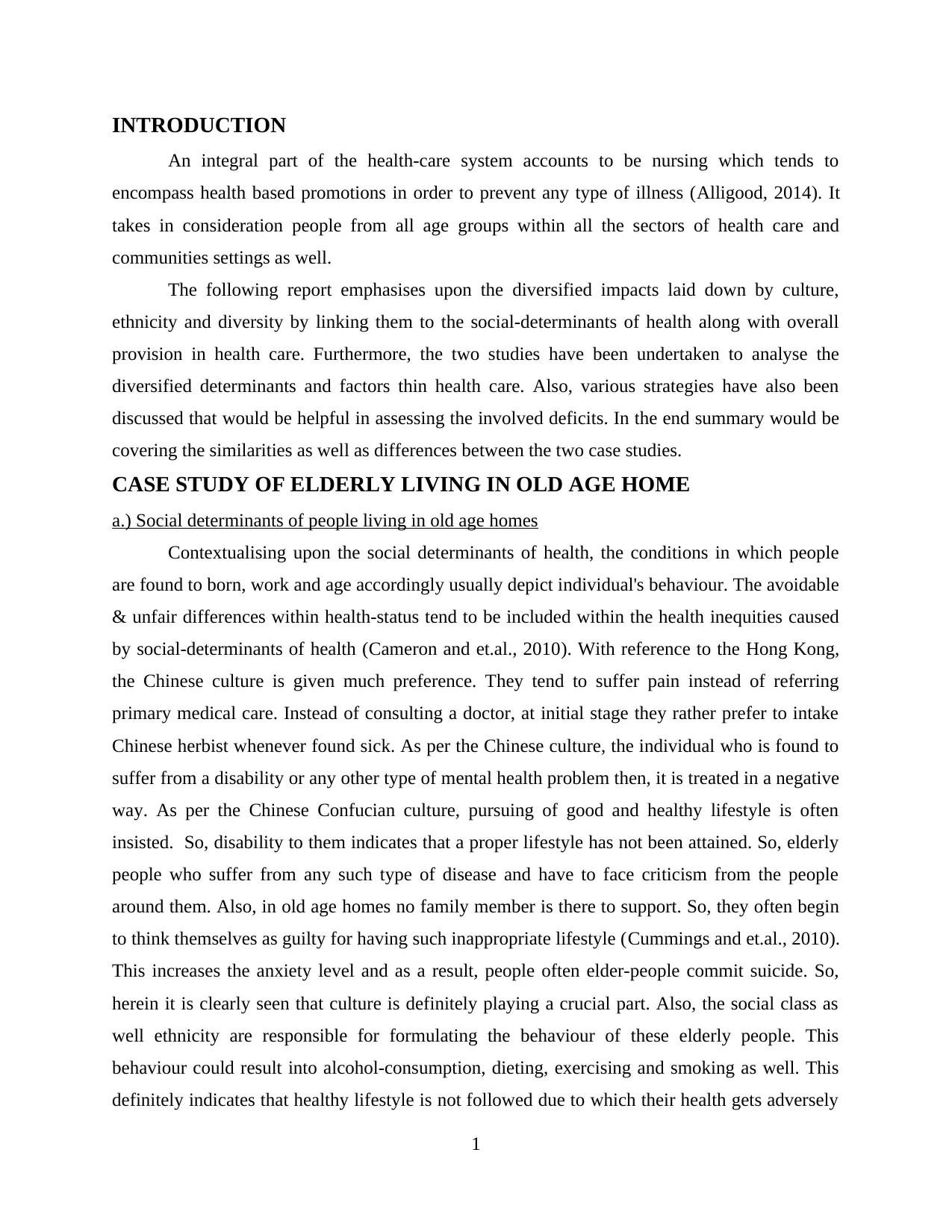
INTRODUCTION
An integral part of the health-care system accounts to be nursing which tends to
encompass health based promotions in order to prevent any type of illness (Alligood, 2014). It
takes in consideration people from all age groups within all the sectors of health care and
communities settings as well.
The following report emphasises upon the diversified impacts laid down by culture,
ethnicity and diversity by linking them to the social-determinants of health along with overall
provision in health care. Furthermore, the two studies have been undertaken to analyse the
diversified determinants and factors thin health care. Also, various strategies have also been
discussed that would be helpful in assessing the involved deficits. In the end summary would be
covering the similarities as well as differences between the two case studies.
CASE STUDY OF ELDERLY LIVING IN OLD AGE HOME
a.) Social determinants of people living in old age homes
Contextualising upon the social determinants of health, the conditions in which people
are found to born, work and age accordingly usually depict individual's behaviour. The avoidable
& unfair differences within health-status tend to be included within the health inequities caused
by social-determinants of health (Cameron and et.al., 2010). With reference to the Hong Kong,
the Chinese culture is given much preference. They tend to suffer pain instead of referring
primary medical care. Instead of consulting a doctor, at initial stage they rather prefer to intake
Chinese herbist whenever found sick. As per the Chinese culture, the individual who is found to
suffer from a disability or any other type of mental health problem then, it is treated in a negative
way. As per the Chinese Confucian culture, pursuing of good and healthy lifestyle is often
insisted. So, disability to them indicates that a proper lifestyle has not been attained. So, elderly
people who suffer from any such type of disease and have to face criticism from the people
around them. Also, in old age homes no family member is there to support. So, they often begin
to think themselves as guilty for having such inappropriate lifestyle (Cummings and et.al., 2010).
This increases the anxiety level and as a result, people often elder-people commit suicide. So,
herein it is clearly seen that culture is definitely playing a crucial part. Also, the social class as
well ethnicity are responsible for formulating the behaviour of these elderly people. This
behaviour could result into alcohol-consumption, dieting, exercising and smoking as well. This
definitely indicates that healthy lifestyle is not followed due to which their health gets adversely
1
An integral part of the health-care system accounts to be nursing which tends to
encompass health based promotions in order to prevent any type of illness (Alligood, 2014). It
takes in consideration people from all age groups within all the sectors of health care and
communities settings as well.
The following report emphasises upon the diversified impacts laid down by culture,
ethnicity and diversity by linking them to the social-determinants of health along with overall
provision in health care. Furthermore, the two studies have been undertaken to analyse the
diversified determinants and factors thin health care. Also, various strategies have also been
discussed that would be helpful in assessing the involved deficits. In the end summary would be
covering the similarities as well as differences between the two case studies.
CASE STUDY OF ELDERLY LIVING IN OLD AGE HOME
a.) Social determinants of people living in old age homes
Contextualising upon the social determinants of health, the conditions in which people
are found to born, work and age accordingly usually depict individual's behaviour. The avoidable
& unfair differences within health-status tend to be included within the health inequities caused
by social-determinants of health (Cameron and et.al., 2010). With reference to the Hong Kong,
the Chinese culture is given much preference. They tend to suffer pain instead of referring
primary medical care. Instead of consulting a doctor, at initial stage they rather prefer to intake
Chinese herbist whenever found sick. As per the Chinese culture, the individual who is found to
suffer from a disability or any other type of mental health problem then, it is treated in a negative
way. As per the Chinese Confucian culture, pursuing of good and healthy lifestyle is often
insisted. So, disability to them indicates that a proper lifestyle has not been attained. So, elderly
people who suffer from any such type of disease and have to face criticism from the people
around them. Also, in old age homes no family member is there to support. So, they often begin
to think themselves as guilty for having such inappropriate lifestyle (Cummings and et.al., 2010).
This increases the anxiety level and as a result, people often elder-people commit suicide. So,
herein it is clearly seen that culture is definitely playing a crucial part. Also, the social class as
well ethnicity are responsible for formulating the behaviour of these elderly people. This
behaviour could result into alcohol-consumption, dieting, exercising and smoking as well. This
definitely indicates that healthy lifestyle is not followed due to which their health gets adversely
1
⊘ This is a preview!⊘
Do you want full access?
Subscribe today to unlock all pages.

Trusted by 1+ million students worldwide
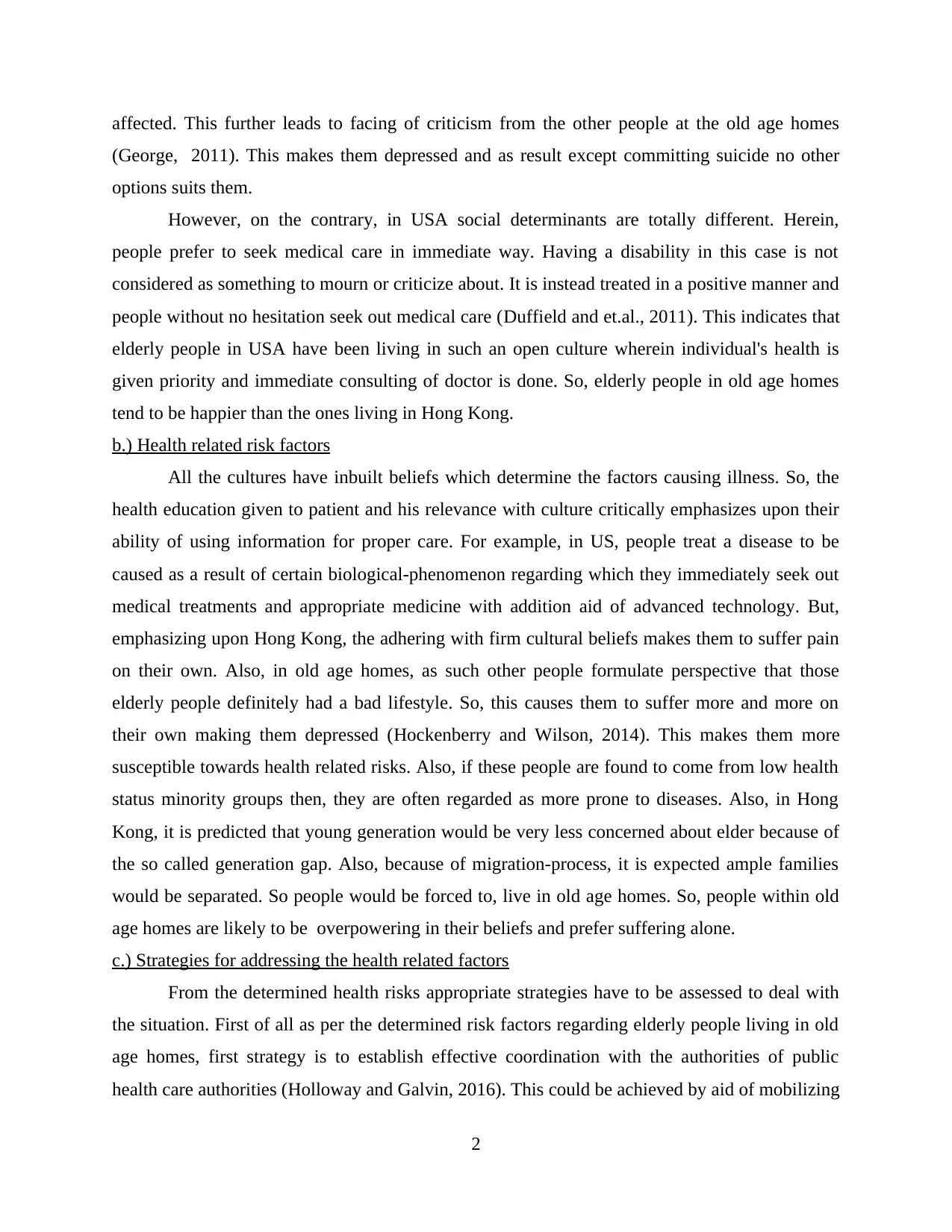
affected. This further leads to facing of criticism from the other people at the old age homes
(George, 2011). This makes them depressed and as result except committing suicide no other
options suits them.
However, on the contrary, in USA social determinants are totally different. Herein,
people prefer to seek medical care in immediate way. Having a disability in this case is not
considered as something to mourn or criticize about. It is instead treated in a positive manner and
people without no hesitation seek out medical care (Duffield and et.al., 2011). This indicates that
elderly people in USA have been living in such an open culture wherein individual's health is
given priority and immediate consulting of doctor is done. So, elderly people in old age homes
tend to be happier than the ones living in Hong Kong.
b.) Health related risk factors
All the cultures have inbuilt beliefs which determine the factors causing illness. So, the
health education given to patient and his relevance with culture critically emphasizes upon their
ability of using information for proper care. For example, in US, people treat a disease to be
caused as a result of certain biological-phenomenon regarding which they immediately seek out
medical treatments and appropriate medicine with addition aid of advanced technology. But,
emphasizing upon Hong Kong, the adhering with firm cultural beliefs makes them to suffer pain
on their own. Also, in old age homes, as such other people formulate perspective that those
elderly people definitely had a bad lifestyle. So, this causes them to suffer more and more on
their own making them depressed (Hockenberry and Wilson, 2014). This makes them more
susceptible towards health related risks. Also, if these people are found to come from low health
status minority groups then, they are often regarded as more prone to diseases. Also, in Hong
Kong, it is predicted that young generation would be very less concerned about elder because of
the so called generation gap. Also, because of migration-process, it is expected ample families
would be separated. So people would be forced to, live in old age homes. So, people within old
age homes are likely to be overpowering in their beliefs and prefer suffering alone.
c.) Strategies for addressing the health related factors
From the determined health risks appropriate strategies have to be assessed to deal with
the situation. First of all as per the determined risk factors regarding elderly people living in old
age homes, first strategy is to establish effective coordination with the authorities of public
health care authorities (Holloway and Galvin, 2016). This could be achieved by aid of mobilizing
2
(George, 2011). This makes them depressed and as result except committing suicide no other
options suits them.
However, on the contrary, in USA social determinants are totally different. Herein,
people prefer to seek medical care in immediate way. Having a disability in this case is not
considered as something to mourn or criticize about. It is instead treated in a positive manner and
people without no hesitation seek out medical care (Duffield and et.al., 2011). This indicates that
elderly people in USA have been living in such an open culture wherein individual's health is
given priority and immediate consulting of doctor is done. So, elderly people in old age homes
tend to be happier than the ones living in Hong Kong.
b.) Health related risk factors
All the cultures have inbuilt beliefs which determine the factors causing illness. So, the
health education given to patient and his relevance with culture critically emphasizes upon their
ability of using information for proper care. For example, in US, people treat a disease to be
caused as a result of certain biological-phenomenon regarding which they immediately seek out
medical treatments and appropriate medicine with addition aid of advanced technology. But,
emphasizing upon Hong Kong, the adhering with firm cultural beliefs makes them to suffer pain
on their own. Also, in old age homes, as such other people formulate perspective that those
elderly people definitely had a bad lifestyle. So, this causes them to suffer more and more on
their own making them depressed (Hockenberry and Wilson, 2014). This makes them more
susceptible towards health related risks. Also, if these people are found to come from low health
status minority groups then, they are often regarded as more prone to diseases. Also, in Hong
Kong, it is predicted that young generation would be very less concerned about elder because of
the so called generation gap. Also, because of migration-process, it is expected ample families
would be separated. So people would be forced to, live in old age homes. So, people within old
age homes are likely to be overpowering in their beliefs and prefer suffering alone.
c.) Strategies for addressing the health related factors
From the determined health risks appropriate strategies have to be assessed to deal with
the situation. First of all as per the determined risk factors regarding elderly people living in old
age homes, first strategy is to establish effective coordination with the authorities of public
health care authorities (Holloway and Galvin, 2016). This could be achieved by aid of mobilizing
2
Paraphrase This Document
Need a fresh take? Get an instant paraphrase of this document with our AI Paraphraser
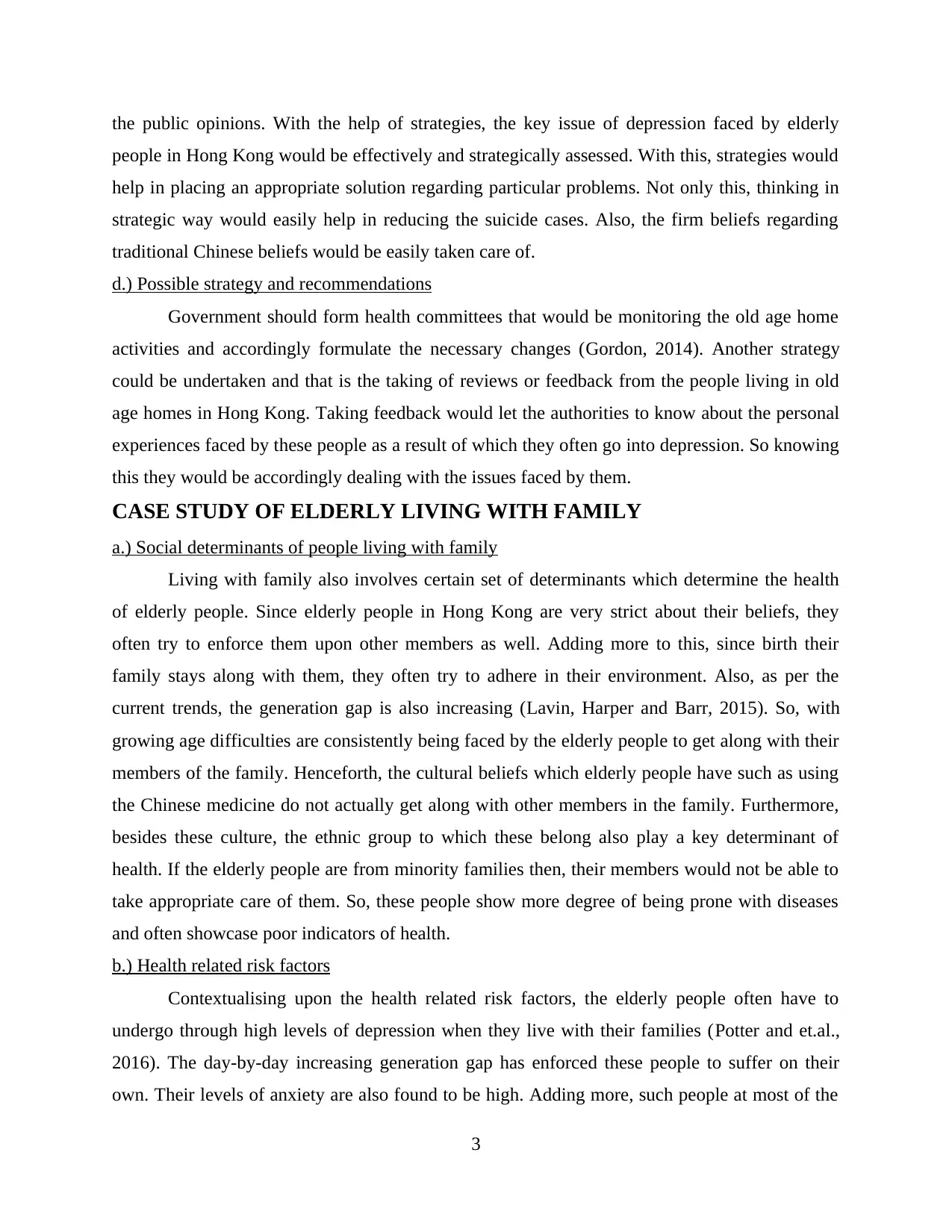
the public opinions. With the help of strategies, the key issue of depression faced by elderly
people in Hong Kong would be effectively and strategically assessed. With this, strategies would
help in placing an appropriate solution regarding particular problems. Not only this, thinking in
strategic way would easily help in reducing the suicide cases. Also, the firm beliefs regarding
traditional Chinese beliefs would be easily taken care of.
d.) Possible strategy and recommendations
Government should form health committees that would be monitoring the old age home
activities and accordingly formulate the necessary changes (Gordon, 2014). Another strategy
could be undertaken and that is the taking of reviews or feedback from the people living in old
age homes in Hong Kong. Taking feedback would let the authorities to know about the personal
experiences faced by these people as a result of which they often go into depression. So knowing
this they would be accordingly dealing with the issues faced by them.
CASE STUDY OF ELDERLY LIVING WITH FAMILY
a.) Social determinants of people living with family
Living with family also involves certain set of determinants which determine the health
of elderly people. Since elderly people in Hong Kong are very strict about their beliefs, they
often try to enforce them upon other members as well. Adding more to this, since birth their
family stays along with them, they often try to adhere in their environment. Also, as per the
current trends, the generation gap is also increasing (Lavin, Harper and Barr, 2015). So, with
growing age difficulties are consistently being faced by the elderly people to get along with their
members of the family. Henceforth, the cultural beliefs which elderly people have such as using
the Chinese medicine do not actually get along with other members in the family. Furthermore,
besides these culture, the ethnic group to which these belong also play a key determinant of
health. If the elderly people are from minority families then, their members would not be able to
take appropriate care of them. So, these people show more degree of being prone with diseases
and often showcase poor indicators of health.
b.) Health related risk factors
Contextualising upon the health related risk factors, the elderly people often have to
undergo through high levels of depression when they live with their families (Potter and et.al.,
2016). The day-by-day increasing generation gap has enforced these people to suffer on their
own. Their levels of anxiety are also found to be high. Adding more, such people at most of the
3
people in Hong Kong would be effectively and strategically assessed. With this, strategies would
help in placing an appropriate solution regarding particular problems. Not only this, thinking in
strategic way would easily help in reducing the suicide cases. Also, the firm beliefs regarding
traditional Chinese beliefs would be easily taken care of.
d.) Possible strategy and recommendations
Government should form health committees that would be monitoring the old age home
activities and accordingly formulate the necessary changes (Gordon, 2014). Another strategy
could be undertaken and that is the taking of reviews or feedback from the people living in old
age homes in Hong Kong. Taking feedback would let the authorities to know about the personal
experiences faced by these people as a result of which they often go into depression. So knowing
this they would be accordingly dealing with the issues faced by them.
CASE STUDY OF ELDERLY LIVING WITH FAMILY
a.) Social determinants of people living with family
Living with family also involves certain set of determinants which determine the health
of elderly people. Since elderly people in Hong Kong are very strict about their beliefs, they
often try to enforce them upon other members as well. Adding more to this, since birth their
family stays along with them, they often try to adhere in their environment. Also, as per the
current trends, the generation gap is also increasing (Lavin, Harper and Barr, 2015). So, with
growing age difficulties are consistently being faced by the elderly people to get along with their
members of the family. Henceforth, the cultural beliefs which elderly people have such as using
the Chinese medicine do not actually get along with other members in the family. Furthermore,
besides these culture, the ethnic group to which these belong also play a key determinant of
health. If the elderly people are from minority families then, their members would not be able to
take appropriate care of them. So, these people show more degree of being prone with diseases
and often showcase poor indicators of health.
b.) Health related risk factors
Contextualising upon the health related risk factors, the elderly people often have to
undergo through high levels of depression when they live with their families (Potter and et.al.,
2016). The day-by-day increasing generation gap has enforced these people to suffer on their
own. Their levels of anxiety are also found to be high. Adding more, such people at most of the
3
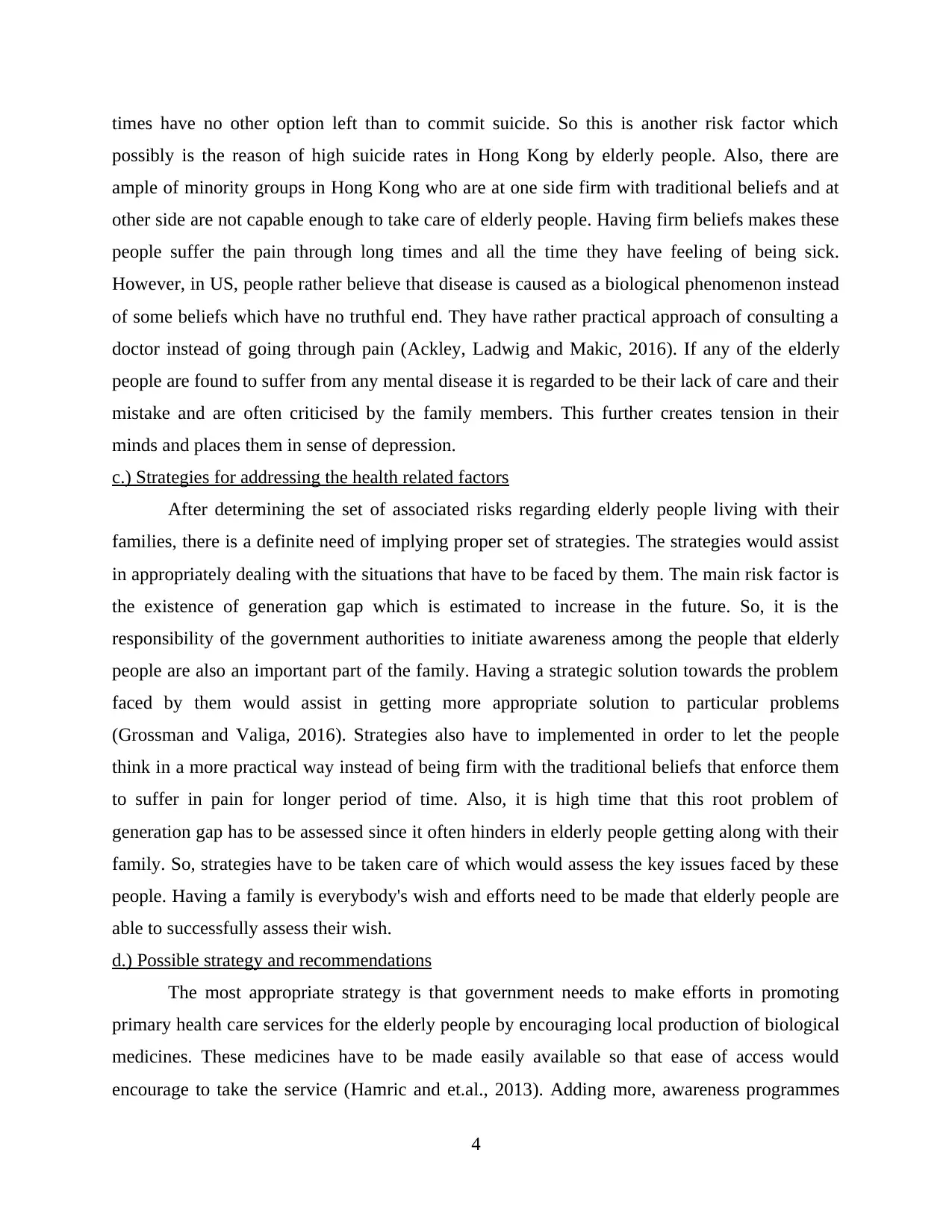
times have no other option left than to commit suicide. So this is another risk factor which
possibly is the reason of high suicide rates in Hong Kong by elderly people. Also, there are
ample of minority groups in Hong Kong who are at one side firm with traditional beliefs and at
other side are not capable enough to take care of elderly people. Having firm beliefs makes these
people suffer the pain through long times and all the time they have feeling of being sick.
However, in US, people rather believe that disease is caused as a biological phenomenon instead
of some beliefs which have no truthful end. They have rather practical approach of consulting a
doctor instead of going through pain (Ackley, Ladwig and Makic, 2016). If any of the elderly
people are found to suffer from any mental disease it is regarded to be their lack of care and their
mistake and are often criticised by the family members. This further creates tension in their
minds and places them in sense of depression.
c.) Strategies for addressing the health related factors
After determining the set of associated risks regarding elderly people living with their
families, there is a definite need of implying proper set of strategies. The strategies would assist
in appropriately dealing with the situations that have to be faced by them. The main risk factor is
the existence of generation gap which is estimated to increase in the future. So, it is the
responsibility of the government authorities to initiate awareness among the people that elderly
people are also an important part of the family. Having a strategic solution towards the problem
faced by them would assist in getting more appropriate solution to particular problems
(Grossman and Valiga, 2016). Strategies also have to implemented in order to let the people
think in a more practical way instead of being firm with the traditional beliefs that enforce them
to suffer in pain for longer period of time. Also, it is high time that this root problem of
generation gap has to be assessed since it often hinders in elderly people getting along with their
family. So, strategies have to be taken care of which would assess the key issues faced by these
people. Having a family is everybody's wish and efforts need to be made that elderly people are
able to successfully assess their wish.
d.) Possible strategy and recommendations
The most appropriate strategy is that government needs to make efforts in promoting
primary health care services for the elderly people by encouraging local production of biological
medicines. These medicines have to be made easily available so that ease of access would
encourage to take the service (Hamric and et.al., 2013). Adding more, awareness programmes
4
possibly is the reason of high suicide rates in Hong Kong by elderly people. Also, there are
ample of minority groups in Hong Kong who are at one side firm with traditional beliefs and at
other side are not capable enough to take care of elderly people. Having firm beliefs makes these
people suffer the pain through long times and all the time they have feeling of being sick.
However, in US, people rather believe that disease is caused as a biological phenomenon instead
of some beliefs which have no truthful end. They have rather practical approach of consulting a
doctor instead of going through pain (Ackley, Ladwig and Makic, 2016). If any of the elderly
people are found to suffer from any mental disease it is regarded to be their lack of care and their
mistake and are often criticised by the family members. This further creates tension in their
minds and places them in sense of depression.
c.) Strategies for addressing the health related factors
After determining the set of associated risks regarding elderly people living with their
families, there is a definite need of implying proper set of strategies. The strategies would assist
in appropriately dealing with the situations that have to be faced by them. The main risk factor is
the existence of generation gap which is estimated to increase in the future. So, it is the
responsibility of the government authorities to initiate awareness among the people that elderly
people are also an important part of the family. Having a strategic solution towards the problem
faced by them would assist in getting more appropriate solution to particular problems
(Grossman and Valiga, 2016). Strategies also have to implemented in order to let the people
think in a more practical way instead of being firm with the traditional beliefs that enforce them
to suffer in pain for longer period of time. Also, it is high time that this root problem of
generation gap has to be assessed since it often hinders in elderly people getting along with their
family. So, strategies have to be taken care of which would assess the key issues faced by these
people. Having a family is everybody's wish and efforts need to be made that elderly people are
able to successfully assess their wish.
d.) Possible strategy and recommendations
The most appropriate strategy is that government needs to make efforts in promoting
primary health care services for the elderly people by encouraging local production of biological
medicines. These medicines have to be made easily available so that ease of access would
encourage to take the service (Hamric and et.al., 2013). Adding more, awareness programmes
4
⊘ This is a preview!⊘
Do you want full access?
Subscribe today to unlock all pages.

Trusted by 1+ million students worldwide
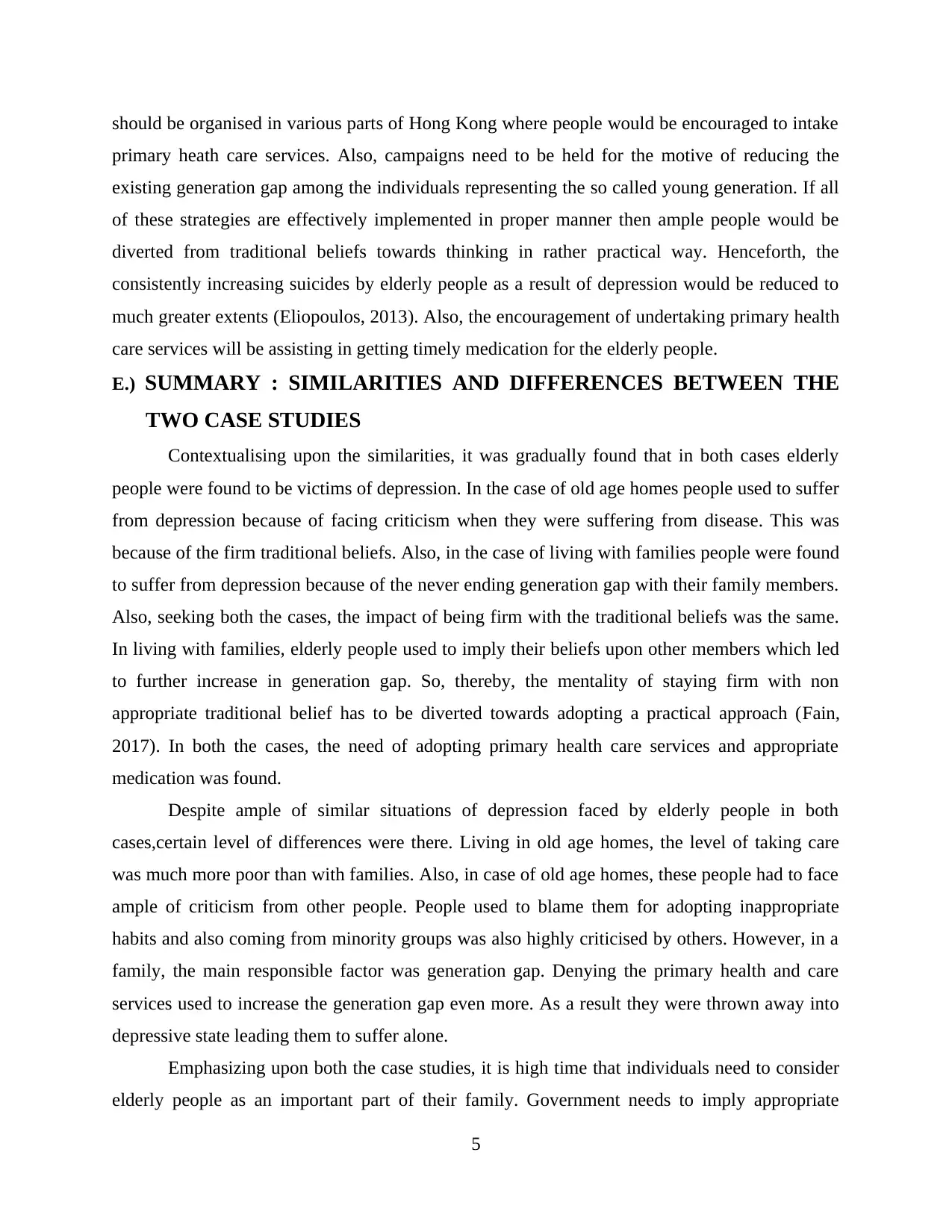
should be organised in various parts of Hong Kong where people would be encouraged to intake
primary heath care services. Also, campaigns need to be held for the motive of reducing the
existing generation gap among the individuals representing the so called young generation. If all
of these strategies are effectively implemented in proper manner then ample people would be
diverted from traditional beliefs towards thinking in rather practical way. Henceforth, the
consistently increasing suicides by elderly people as a result of depression would be reduced to
much greater extents (Eliopoulos, 2013). Also, the encouragement of undertaking primary health
care services will be assisting in getting timely medication for the elderly people.
E.) SUMMARY : SIMILARITIES AND DIFFERENCES BETWEEN THE
TWO CASE STUDIES
Contextualising upon the similarities, it was gradually found that in both cases elderly
people were found to be victims of depression. In the case of old age homes people used to suffer
from depression because of facing criticism when they were suffering from disease. This was
because of the firm traditional beliefs. Also, in the case of living with families people were found
to suffer from depression because of the never ending generation gap with their family members.
Also, seeking both the cases, the impact of being firm with the traditional beliefs was the same.
In living with families, elderly people used to imply their beliefs upon other members which led
to further increase in generation gap. So, thereby, the mentality of staying firm with non
appropriate traditional belief has to be diverted towards adopting a practical approach (Fain,
2017). In both the cases, the need of adopting primary health care services and appropriate
medication was found.
Despite ample of similar situations of depression faced by elderly people in both
cases,certain level of differences were there. Living in old age homes, the level of taking care
was much more poor than with families. Also, in case of old age homes, these people had to face
ample of criticism from other people. People used to blame them for adopting inappropriate
habits and also coming from minority groups was also highly criticised by others. However, in a
family, the main responsible factor was generation gap. Denying the primary health and care
services used to increase the generation gap even more. As a result they were thrown away into
depressive state leading them to suffer alone.
Emphasizing upon both the case studies, it is high time that individuals need to consider
elderly people as an important part of their family. Government needs to imply appropriate
5
primary heath care services. Also, campaigns need to be held for the motive of reducing the
existing generation gap among the individuals representing the so called young generation. If all
of these strategies are effectively implemented in proper manner then ample people would be
diverted from traditional beliefs towards thinking in rather practical way. Henceforth, the
consistently increasing suicides by elderly people as a result of depression would be reduced to
much greater extents (Eliopoulos, 2013). Also, the encouragement of undertaking primary health
care services will be assisting in getting timely medication for the elderly people.
E.) SUMMARY : SIMILARITIES AND DIFFERENCES BETWEEN THE
TWO CASE STUDIES
Contextualising upon the similarities, it was gradually found that in both cases elderly
people were found to be victims of depression. In the case of old age homes people used to suffer
from depression because of facing criticism when they were suffering from disease. This was
because of the firm traditional beliefs. Also, in the case of living with families people were found
to suffer from depression because of the never ending generation gap with their family members.
Also, seeking both the cases, the impact of being firm with the traditional beliefs was the same.
In living with families, elderly people used to imply their beliefs upon other members which led
to further increase in generation gap. So, thereby, the mentality of staying firm with non
appropriate traditional belief has to be diverted towards adopting a practical approach (Fain,
2017). In both the cases, the need of adopting primary health care services and appropriate
medication was found.
Despite ample of similar situations of depression faced by elderly people in both
cases,certain level of differences were there. Living in old age homes, the level of taking care
was much more poor than with families. Also, in case of old age homes, these people had to face
ample of criticism from other people. People used to blame them for adopting inappropriate
habits and also coming from minority groups was also highly criticised by others. However, in a
family, the main responsible factor was generation gap. Denying the primary health and care
services used to increase the generation gap even more. As a result they were thrown away into
depressive state leading them to suffer alone.
Emphasizing upon both the case studies, it is high time that individuals need to consider
elderly people as an important part of their family. Government needs to imply appropriate
5
Paraphrase This Document
Need a fresh take? Get an instant paraphrase of this document with our AI Paraphraser
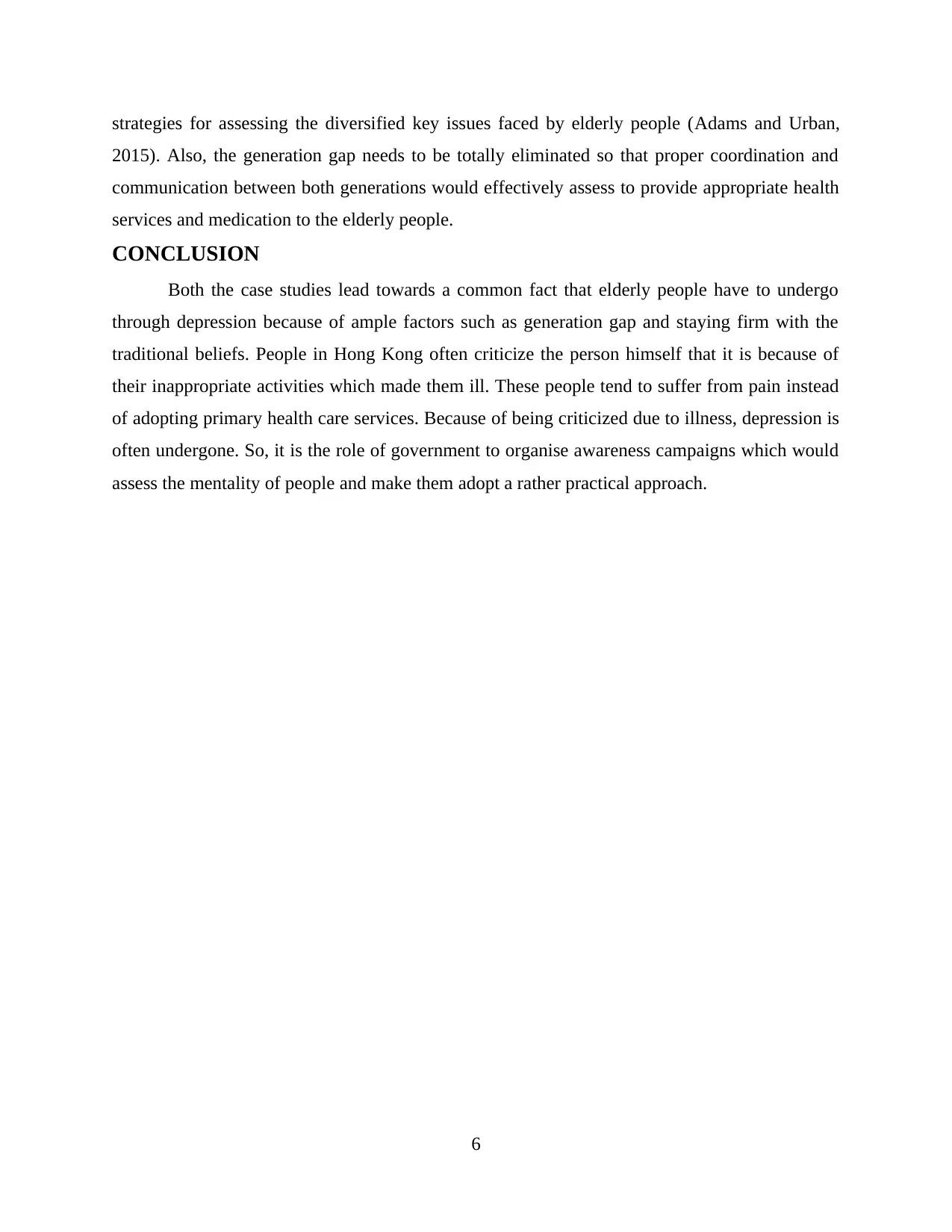
strategies for assessing the diversified key issues faced by elderly people (Adams and Urban,
2015). Also, the generation gap needs to be totally eliminated so that proper coordination and
communication between both generations would effectively assess to provide appropriate health
services and medication to the elderly people.
CONCLUSION
Both the case studies lead towards a common fact that elderly people have to undergo
through depression because of ample factors such as generation gap and staying firm with the
traditional beliefs. People in Hong Kong often criticize the person himself that it is because of
their inappropriate activities which made them ill. These people tend to suffer from pain instead
of adopting primary health care services. Because of being criticized due to illness, depression is
often undergone. So, it is the role of government to organise awareness campaigns which would
assess the mentality of people and make them adopt a rather practical approach.
6
2015). Also, the generation gap needs to be totally eliminated so that proper coordination and
communication between both generations would effectively assess to provide appropriate health
services and medication to the elderly people.
CONCLUSION
Both the case studies lead towards a common fact that elderly people have to undergo
through depression because of ample factors such as generation gap and staying firm with the
traditional beliefs. People in Hong Kong often criticize the person himself that it is because of
their inappropriate activities which made them ill. These people tend to suffer from pain instead
of adopting primary health care services. Because of being criticized due to illness, depression is
often undergone. So, it is the role of government to organise awareness campaigns which would
assess the mentality of people and make them adopt a rather practical approach.
6

REFERENCES
Books and Journals
Alligood, M. R., 2014. Nursing theorists and their work. Elsevier Health Sciences.
Cameron, I. D. and et.al., 2010. Interventions for preventing falls in older people in nursing care
facilities and hospitals. Cochrane Database Syst Rev. 1(1).
Cummings, G. G. and et.al., 2010. Leadership styles and outcome patterns for the nursing
workforce and work environment: a systematic review.International journal of nursing
studies. 47(3). pp.363-385.
Duffield, C. and et.al., 2011. Nursing staffing, nursing workload, the work environment and
patient outcomes. Applied nursing research. 24(4). pp.244-255.
George, J. B., 2011. Nursing Theories: The Base for Professional Nursing Practice, 6/e. Pearson
Education India.
Hockenberry, M. J. and Wilson, D., 2014. Wong's Nursing Care of Infants and Children-E-Book.
Elsevier Health Sciences.
Holloway, I. and Galvin, K., 2016. Qualitative research in nursing and healthcare. John Wiley
& Sons.
Fain, J. A., 2017. Reading, understanding, and applying nursing research. FA Davis.
Eliopoulos, C., 2013. Gerontological nursing. Lippincott Williams & Wilkins.
Hamric, A. B. and et.al., 2013. Advanced Practice Nursing-E-Book: An Integrative Approach.
Elsevier Health Sciences.
Grossman, S. and Valiga, T. M., 2016. The new leadership challenge: Creating the future of
nursing. FA Davis.
Ackley, B. J., Ladwig, G. B. and Makic, M. B. F., 2016. Nursing Diagnosis Handbook-E-Book:
An Evidence-Based Guide to Planning Care. Elsevier Health Sciences.
Potter, P. A. and et.al., 2016. Fundamentals of Nursing-E-Book. Elsevier Health Sciences.
Lavin, M., Harper, E. and Barr, N., 2015. Health information technology, patient safety, and
professional nursing care documentation in acute care settings. OJIN: The Online Journal of
Issues in Nursing. 20(2).
Gordon, M., 2014. Manual of nursing diagnosis. Jones & Bartlett Publishers.
Adams, M. and Urban, C. Q., 2015. Pharmacology: Connections to nursing practice (p. 1552).
Prentice Hall.
7
Books and Journals
Alligood, M. R., 2014. Nursing theorists and their work. Elsevier Health Sciences.
Cameron, I. D. and et.al., 2010. Interventions for preventing falls in older people in nursing care
facilities and hospitals. Cochrane Database Syst Rev. 1(1).
Cummings, G. G. and et.al., 2010. Leadership styles and outcome patterns for the nursing
workforce and work environment: a systematic review.International journal of nursing
studies. 47(3). pp.363-385.
Duffield, C. and et.al., 2011. Nursing staffing, nursing workload, the work environment and
patient outcomes. Applied nursing research. 24(4). pp.244-255.
George, J. B., 2011. Nursing Theories: The Base for Professional Nursing Practice, 6/e. Pearson
Education India.
Hockenberry, M. J. and Wilson, D., 2014. Wong's Nursing Care of Infants and Children-E-Book.
Elsevier Health Sciences.
Holloway, I. and Galvin, K., 2016. Qualitative research in nursing and healthcare. John Wiley
& Sons.
Fain, J. A., 2017. Reading, understanding, and applying nursing research. FA Davis.
Eliopoulos, C., 2013. Gerontological nursing. Lippincott Williams & Wilkins.
Hamric, A. B. and et.al., 2013. Advanced Practice Nursing-E-Book: An Integrative Approach.
Elsevier Health Sciences.
Grossman, S. and Valiga, T. M., 2016. The new leadership challenge: Creating the future of
nursing. FA Davis.
Ackley, B. J., Ladwig, G. B. and Makic, M. B. F., 2016. Nursing Diagnosis Handbook-E-Book:
An Evidence-Based Guide to Planning Care. Elsevier Health Sciences.
Potter, P. A. and et.al., 2016. Fundamentals of Nursing-E-Book. Elsevier Health Sciences.
Lavin, M., Harper, E. and Barr, N., 2015. Health information technology, patient safety, and
professional nursing care documentation in acute care settings. OJIN: The Online Journal of
Issues in Nursing. 20(2).
Gordon, M., 2014. Manual of nursing diagnosis. Jones & Bartlett Publishers.
Adams, M. and Urban, C. Q., 2015. Pharmacology: Connections to nursing practice (p. 1552).
Prentice Hall.
7
⊘ This is a preview!⊘
Do you want full access?
Subscribe today to unlock all pages.

Trusted by 1+ million students worldwide

8
1 out of 10
Related Documents
Your All-in-One AI-Powered Toolkit for Academic Success.
+13062052269
info@desklib.com
Available 24*7 on WhatsApp / Email
![[object Object]](/_next/static/media/star-bottom.7253800d.svg)
Unlock your academic potential
Copyright © 2020–2025 A2Z Services. All Rights Reserved. Developed and managed by ZUCOL.





